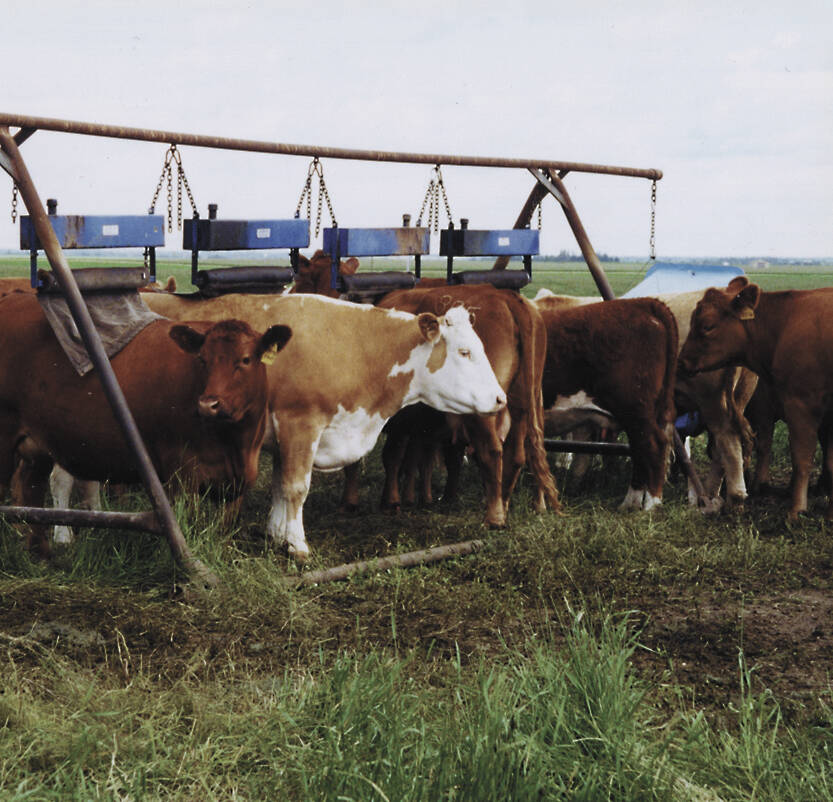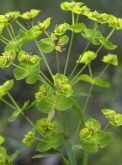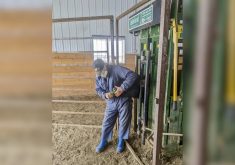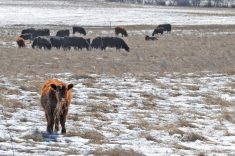Not every attempt to improve a sandy, weed-wracked pasture north of Brandon has been successful for the Manitoba Beef and Forage Initiatives (MBFI). But four years after an experiment on marginal land improvement ended, some plots are going strong.
“The goal was really to look at the success of different methods of introducing alfalfa into an existing grass stand and then compare that to a stand with fertilization only and a control,” said MBFI general manager Mary-Jane Orr.
Why it matters: Starting a new pasture mix from scratch may not be a good option for producers who want the benefit of more legumes but don’t have pastures healthy enough to avoid damage from breaking land.
Read Also

Shifting standards on cattle parasite control
Parasite product resistance has more farmers and veterinarians thinking differently about how to control issues like lice or worms.
When MBFI took over an old research centre pasture, now known as the First Street Pasture site, it found that leafy spurge had thoroughly infested the area and the rest was dominated by smooth brome and Kentucky bluegrass. Soil was light, easily erodible and vulnerable to environmental stress. Other than occasional sweet clover, legumes were almost non-existent.
Those depleted acres were perfect for improvement projects. Researchers tested low-disturbance alfalfa establishment practices, aimed at retaining precious organic matter, reducing erosion and establishing reliable stands.
Without seeding forage, Orr noted, the result is likely to be unproductive, open ground and further pressure from noxious weeds like leafy spurge.

It is a debate that Charlotte Crawley of the Ducks Unlimited Canada Marginal Areas Program hears often.
“I get a lot of questions about, ‘should I rip it up? Is there a way to rejuvenate it without ripping it up?’ and there’s implications for both,” she said. “Obviously, cost comes into account. Breaking land and starting over can be expensive, but the journey back from something that’s kind of beat up is a long road, and it’s not a rapid turnaround.”
By Crawley’s count, it often takes up to three years for sod-seeded legumes to make a noticeable difference.
Trial details
At MBFI, the team hoped that either sod seeding or broadcasting alfalfa seed – followed by a short but intensive mob graze to pound seeds into the ground – might improve quality of hay, fix nitrogen and build organic matter with minimal soil disturbance.
The brainchild of now-retired Manitoba Agriculture forage specialist Jane Thornton, the project started in 2016 and was replicated twice annually for three years.
The two seeding treatments were, in turn, compared to plots that only saw a shot of fertilizer and an untouched control. Both fertilizer-only and seeded plots were given 30 pounds per acre of phosphorus and half that rate of sulphur. Alfalfa seed was also mixed with 11 pounds an acre of elemental sulphur as a carrier.
Three years later, it was clear that rainfall would be key for any producer wanting to try either seeding method.
Plots planted with alfalfa in 2016 and 2017 eventually got good establishment, although broadcast and mob grazing brought the best initial catch. Sod-seeded strips had 4.8 to 6.5 stems per square foot in the year they were established, while mob grazed areas ranged from 13.4 to 20.1 stems per foot.
By last year, however, the seeding treatments had largely evened out. Seeded strips from 2016 and 2017 returned 16.4 to almost 18 alfalfa stems per square foot, regardless of how they were sown.
In the drier conditions of 2018, results were significantly less. Very little alfalfa from either seeding technique caught that year, according to Orr.
“We did have some establishment, but it wasn’t enough to really keep monitoring over time.”
Since the end of the trial, the team at MBFI has continued to measure yield on the plots. Yield benefit on fertility-only plots has faded, perhaps unsurprisingly after four to seven years since treatment, Orr noted, although plots with successful alfalfa were still seeing significant gains.
Last year, despite drought conditions, the team took 2,200 pounds per acre of forage off plots that had been broadcast with alfalfa and mob grazed in 2016. Sod-seeded plots from that year yielded 1,900 pounds per acre.
In comparison, fertility-only and control plots saw 890 to 950 pounds per acre.
In plots planted in 2017, one of the more successful years, fertility alone boosted forage production by 300 pounds an acre, up from 1,400 pounds per acre on control plots.
However, both seeding techniques were very much ahead. Plots that had been sod-seeded provided 2,800 pounds per acre of forage, while plots that had been broadcast and mob grazed led the pack with 3,000 pounds per acre.
“We’re seeing at least, maybe, two and a quarter times higher productivity five years after seeding, roughly,” Orr said. “We’re still seeing a really prolific impact of introducing alfalfa into that perennial stand and seeing a dramatic doubling of productivity.”
Considerations
Marginal land that is light and overtaken by less desirable grass species may well be a contender for sod-seeding, according to Crawley. She has only seen success with legume mixes such as alfalfa, cicer milkvetch, birdsfoot trefoil or sainfoin, and said seeding more productive grasses into established grass has little chance.
Other advice puts the ideal seeding window in May with rates of seven pounds an acre, and starter phosphorus is also recommended.
Crawley has had experience with the broadcast-mob grazing technique tested at MBFI and sees it as a valid option if the producer has a fair amount of open ground and enough cattle for good hoof action. Thatch is the enemy of the technique, said Crawley, since seed-to-soil contact will be an issue.
Neither option provides an immediate fix.
“You just have to weigh the cost and benefit with, ‘do I need a quick turnaround? Do I need a fast improvement in production?’ and if the answer to those two things are yes, you might be better off looking at starting over again,” Crawley said.
“If you’re on a site that is risky to break, such as something that’s really sandy, something that’s really stony that you might not want to take breaking equipment over, something with a little bit more challenging terrain, those variables might work better for a sod seed.”
Equipment will be another deciding factor, both Orr and Crawley said. Both emphasized the importance of having the proper drill for sod seeding.
The MBFI project used a 10-foot double press drill, though it was not designed for that type of work.
“I would expect to see a much higher establishment success with a no-till disc drill or some other kind of no-till drill that would allow you to have better soil to seed contact,” Orr said.
“One thing that this demonstration does tell us is that, in years that we had moisture, this drill that didn’t have the target seed-to-soil contact ended up having some results that were maybe more comparable to what you would get with broadcasting and mob grazing.
“And that, in years with good moisture, broadcasting and mob grazing, even if you don’t have equipment, can be a really successful way of establishing alfalfa into a marginal pasture.”
Crawley said a drill with wider openers will have issues with soil to seed contact, “without making a real lumpy mess of the field.
“In that instance, I think I would recommend breaking if you don’t have access to the correct equipment.”
The Thornton study will become the foundation for expanded work at MBFI. Orr says the facility is looking at a revised version of the same sod-seeded and broadcast-mob grazed experiment, this time with more species. That work may start next season.
















